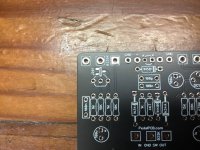I just received new boards for a Duo Cast and Carmine Drive.
First question: On the back of the Duo Cast are two small rectangular pads (looks like the pause symbol), what are these? It looks like I may be a solder jumper if I were to forgo that component.
Second question: Above the J201 on the Carmine Drive is what I guess is a place to solder a SMD J201, if I bought a standard J201 would I just install it and ignore the SMD pads?
Last question: How do you socket Transistors?
I bought a socket strip to make my own transistor sockets, so for the J201 I’ll just break a line of 3 sockets, for the OC71 and BC549C I plan on breaking 3 pins of and adhere them in the right configuration (probably super glue, or sticky tack). Then solder them in. Do you just push the transistor in, or if the transistor sounds good do you have to solder it in the socket?
Thank you for any help


First question: On the back of the Duo Cast are two small rectangular pads (looks like the pause symbol), what are these? It looks like I may be a solder jumper if I were to forgo that component.
Second question: Above the J201 on the Carmine Drive is what I guess is a place to solder a SMD J201, if I bought a standard J201 would I just install it and ignore the SMD pads?
Last question: How do you socket Transistors?
I bought a socket strip to make my own transistor sockets, so for the J201 I’ll just break a line of 3 sockets, for the OC71 and BC549C I plan on breaking 3 pins of and adhere them in the right configuration (probably super glue, or sticky tack). Then solder them in. Do you just push the transistor in, or if the transistor sounds good do you have to solder it in the socket?
Thank you for any help



